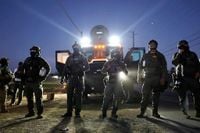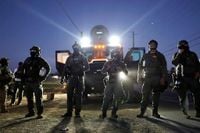For more than 15 years, officers with Immigration and Customs Enforcement (ICE) were required to complete a detailed worksheet before making an arrest. This paperwork, known officially as the field operations worksheet, demanded information on a person’s name, appearance, employer, last known address, immigration history, and any criminal background. Supervisors had to approve these forms before agents could proceed. But as of the summer of 2025, this long-standing requirement has been quietly scrapped, signaling a dramatic shift in how ICE operates under President Donald Trump’s administration, according to NBC News and corroborated by multiple current and former agency officials.
The move away from paperwork is not just bureaucratic housekeeping. It reflects a broader, more urgent push from the highest levels of government to ramp up immigration enforcement—often at the expense of targeted, case-by-case operations. Six current and former ICE and Department of Homeland Security (DHS) officials told NBC News that this change was communicated down from DHS leadership, with the intention of expediting the process and boosting arrest numbers. Darius Reeves, the former director of ICE’s Baltimore field office, recalled, “The worksheet is seen as a waste of time, but I believe it is actually a very valuable necessity.” He explained that the policy was bypassed “so they could keep constantly flooding the streets” with officers.
The pressure to deliver results has been intense. In May 2025, White House deputy chief of staff Stephen Miller reportedly berated ICE officials, threatening to fire field office leaders if the agency didn’t start making at least 3,000 arrests per day. According to NBC News, this demand led to a shift away from the previously stated focus on immigrants with criminal histories. Instead, ICE began to conduct broad sweeps in areas known to be frequented by undocumented immigrants—places like Home Depot parking lots and neighborhoods with large immigrant populations.
“It’s hard to fill out a worksheet that just says, ‘Meet in the Home Depot parking lot,’” one former ICE official told NBC News, highlighting the change from targeted enforcement to more indiscriminate sweeps. This approach, critics say, blurs the line between focused law enforcement and arbitrary stops, raising concerns about racial and linguistic profiling.
Indeed, concerns about profiling prompted legal intervention over the summer. In July 2025, a federal judge in Los Angeles issued a temporary restraining order that blocked ICE from conducting “roving patrols” and from using race or language—such as speaking Spanish—as grounds for detaining people. The impact of the order was immediate and dramatic. David J. Bier of the libertarian Cato Institute analyzed data showing that ICE arrests in the Los Angeles area dropped by 66% after the judge’s order, falling from 756 arrests in the week before the order to just 258 two weeks later.
But that reprieve was short-lived. On Monday, September 8, 2025, the Supreme Court voted 6-3 to lift the judge’s order, removing the restrictions on ICE’s ability to conduct stops in Los Angeles. The decision effectively greenlights the resumption of broader enforcement tactics not just in L.A., but also in other cities like Washington, D.C., and soon, Chicago. The ruling has sent ripples of anxiety through immigrant communities and civil rights advocates alike, who fear a return to indiscriminate sweeps and increased racial profiling.
The practical effects of these policy changes have already been felt on the ground. NBC News reported on the experience of Raquel Sánchez and her husband, Jesus Muñoz Colorado, who were stopped by a group of officers—including ICE agents—in Washington, D.C. early one morning in August. Seven unmarked cars surrounded their vehicle, and officers threatened to shatter the windows if the couple didn’t comply. Sánchez and Colorado, who were in the process of applying for U visas as victims of crime, were handcuffed and taken to a local ICE facility. Sánchez was released, but her husband remains in detention. Their lawyer, Julia Toro, said she has seen a spike in arrests of clients with no criminal backgrounds since the crackdown began. “The officers ask them, ‘Do you have any documents and do you have any papers? Show me,’” Toro told NBC News. “It’s not like they know who they are picking up. They are arbitrary stops.”
Despite denials from top DHS and ICE officials—Homeland Security Secretary Kristi Noem insisted that “every single operation” is based on “investigative work and on casework,” and acting ICE Director Todd Lyons described the efforts as “targeted enforcement operations”—multiple sources within the agency have pushed back on this narrative. One former ICE official told NBC News, “They’re bending the definition of ‘targeted’ to conform with their operations. By ‘targeted,’ they might mean going to an area where they can find immigrants.”
For some officers, the elimination of the worksheet requirement is not just a matter of efficiency—it’s a source of legal risk. The documentation not only helped plan and justify arrests, but also served as a safeguard for officers in the event of lawsuits. Paul Hunker, former ICE chief counsel in Dallas, explained, “What’s critical is that ICE has to articulate probable cause to arrest, so the worksheet might be helpful for them if they get challenged on that.” Without this paperwork, officers could be more vulnerable to civil rights lawsuits if they are accused of making arrests without probable cause.
Some ICE officers, aware of the risks, continue to use the worksheets voluntarily. The forms also provided important safety information—sometimes officers would attach additional sheets noting whether a target might be armed, a detail that could keep agents safe in the field. As one former DHS official put it, “For a professional law enforcement agency, you don’t just fly willy-nilly. Crossing your T’s, dotting your I’s, checking with OPLA [Office of the Principal Legal Advisor]… it’s truly protecting them to make sure they are actually operating within their legal bounds.”
Meanwhile, DHS is preparing to ramp up operations in Chicago, building a staging area at a naval base north of the city and bringing in additional ICE and Border Patrol agents. While officials claim they are working from a list of “high-value” targets—immigrants who have committed crimes—recent events in Los Angeles and Washington suggest that many arrests are still being made at random, in pursuit of ambitious daily quotas.
ICE did not respond to multiple requests for comment from NBC News. The agency’s silence has only fueled further debate over the real motives and consequences of these sweeping changes. For immigrant communities and their advocates, the end of the worksheet era marks not just a bureaucratic shift, but a stark warning: the rules of engagement have changed, and the margin for error—and for abuse—may be wider than ever.
As the nation watches the fallout from the Supreme Court’s decision and the Trump administration’s ever-escalating enforcement priorities, the fate of due process and civil rights in immigration enforcement remains an open—and urgent—question.





